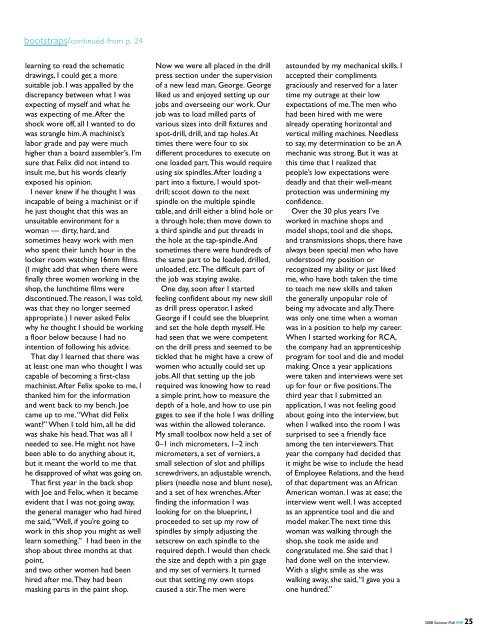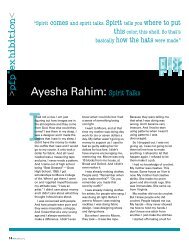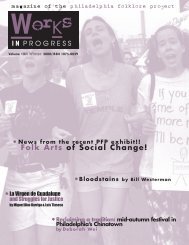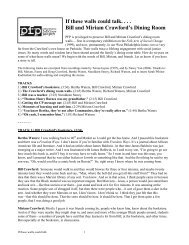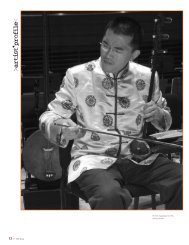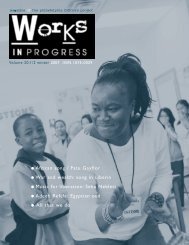View PDF - Philadelphia Folklore Project
View PDF - Philadelphia Folklore Project
View PDF - Philadelphia Folklore Project
You also want an ePaper? Increase the reach of your titles
YUMPU automatically turns print PDFs into web optimized ePapers that Google loves.
ootstraps/continued from p. 24<br />
learning to read the schematic<br />
drawings, I could get a more<br />
suitable job. I was appalled by the<br />
discrepancy between what I was<br />
expecting of myself and what he<br />
was expecting of me. After the<br />
shock wore off, all I wanted to do<br />
was strangle him. A machinist’s<br />
labor grade and pay were much<br />
higher than a board assembler’s. I’m<br />
sure that Felix did not intend to<br />
insult me, but his words clearly<br />
exposed his opinion.<br />
I never knew if he thought I was<br />
incapable of being a machinist or if<br />
he just thought that this was an<br />
unsuitable environment for a<br />
woman — dirty, hard, and<br />
sometimes heavy work with men<br />
who spent their lunch hour in the<br />
locker room watching 16mm films.<br />
(I might add that when there were<br />
finally three women working in the<br />
shop, the lunchtime films were<br />
discontinued. The reason, I was told,<br />
was that they no longer seemed<br />
appropriate.) I never asked Felix<br />
why he thought I should be working<br />
a floor below because I had no<br />
intention of following his advice.<br />
That day I learned that there was<br />
at least one man who thought I was<br />
capable of becoming a first-class<br />
machinist. After Felix spoke to me, I<br />
thanked him for the information<br />
and went back to my bench. Joe<br />
came up to me. “What did Felix<br />
want” When I told him, all he did<br />
was shake his head. That was all I<br />
needed to see. He might not have<br />
been able to do anything about it,<br />
but it meant the world to me that<br />
he disapproved of what was going on.<br />
That first year in the back shop<br />
with Joe and Felix, when it became<br />
evident that I was not going away,<br />
the general manager who had hired<br />
me said, “Well, if you’re going to<br />
work in this shop you might as well<br />
learn something.” I had been in the<br />
shop about three months at that<br />
point,<br />
and two other women had been<br />
hired after me. They had been<br />
masking parts in the paint shop.<br />
Now we were all placed in the drill<br />
press section under the supervision<br />
of a new lead man, George. George<br />
liked us and enjoyed setting up our<br />
jobs and overseeing our work. Our<br />
job was to load milled parts of<br />
various sizes into drill fixtures and<br />
spot-drill, drill, and tap holes. At<br />
times there were four to six<br />
different procedures to execute on<br />
one loaded part. This would require<br />
using six spindles. After loading a<br />
part into a fixture, I would spotdrill;<br />
scoot down to the next<br />
spindle on the multiple spindle<br />
table, and drill either a blind hole or<br />
a through hole; then move down to<br />
a third spindle and put threads in<br />
the hole at the tap-spindle. And<br />
sometimes there were hundreds of<br />
the same part to be loaded, drilled,<br />
unloaded, etc. The difficult part of<br />
the job was staying awake.<br />
One day, soon after I started<br />
feeling confident about my new skill<br />
as drill press operator, I asked<br />
George if I could see the blueprint<br />
and set the hole depth myself. He<br />
had seen that we were competent<br />
on the drill press and seemed to be<br />
tickled that he might have a crew of<br />
women who actually could set up<br />
jobs. All that setting up the job<br />
required was knowing how to read<br />
a simple print, how to measure the<br />
depth of a hole, and how to use pin<br />
gages to see if the hole I was drilling<br />
was within the allowed tolerance.<br />
My small toolbox now held a set of<br />
0–1 inch micrometers, 1–2 inch<br />
micrometers, a set of verniers, a<br />
small selection of slot and phillips<br />
screwdrivers, an adjustable wrench,<br />
pliers (needle nose and blunt nose),<br />
and a set of hex wrenches. After<br />
finding the information I was<br />
looking for on the blueprint, I<br />
proceeded to set up my row of<br />
spindles by simply adjusting the<br />
setscrew on each spindle to the<br />
required depth. I would then check<br />
the size and depth with a pin gage<br />
and my set of verniers. It turned<br />
out that setting my own stops<br />
caused a stir. The men were<br />
astounded by my mechanical skills. I<br />
accepted their compliments<br />
graciously and reserved for a later<br />
time my outrage at their low<br />
expectations of me. The men who<br />
had been hired with me were<br />
already operating horizontal and<br />
vertical milling machines. Needless<br />
to say, my determination to be an A<br />
mechanic was strong. But it was at<br />
this time that I realized that<br />
people’s low expectations were<br />
deadly and that their well-meant<br />
protection was undermining my<br />
confidence.<br />
Over the 30 plus years I’ve<br />
worked in machine shops and<br />
model shops, tool and die shops,<br />
and transmissions shops, there have<br />
always been special men who have<br />
understood my position or<br />
recognized my ability or just liked<br />
me, who have both taken the time<br />
to teach me new skills and taken<br />
the generally unpopular role of<br />
being my advocate and ally. There<br />
was only one time when a woman<br />
was in a position to help my career.<br />
When I started working for RCA,<br />
the company had an apprenticeship<br />
program for tool and die and model<br />
making. Once a year applications<br />
were taken and interviews were set<br />
up for four or five positions. The<br />
third year that I submitted an<br />
application, I was not feeling good<br />
about going into the interview, but<br />
when I walked into the room I was<br />
surprised to see a friendly face<br />
among the ten interviewers. That<br />
year the company had decided that<br />
it might be wise to include the head<br />
of Employee Relations, and the head<br />
of that department was an African<br />
American woman. I was at ease; the<br />
interview went well. I was accepted<br />
as an apprentice tool and die and<br />
model maker. The next time this<br />
woman was walking through the<br />
shop, she took me aside and<br />
congratulated me. She said that I<br />
had done well on the interview.<br />
With a slight smile as she was<br />
walking away, she said, “I gave you a<br />
one hundred.”<br />
2008 Summer /Fall WIP 25


